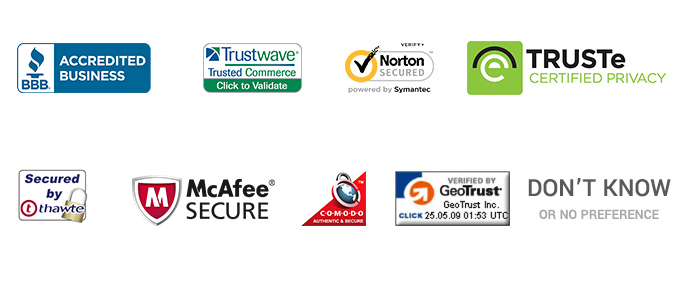Dynamic Site Seals offer immediate, indisputable assurance of SSL protection
Have you ever been so nervous about being robbed that you hid your whole wallet in your rectum? No? Me neither…
I am however convinced that Google planted a tracking chip in me during an airport cavity search in Atlanta back in 2003. How else does my smart phone know where I am, where I’m going and what the weather is like there? [Editor’s Note: By that logic, wouldn’t it always be 98.6 degr—just grossed myself out].
Anyway, today we’re going to talk about Site Seals—those little images that appear on websites that say things like “Norton Secured” or “Thawte Trusted.” Those are there for a reason, to offer assurance. And on a big, scary place like the Internet—a little assurance goes a long way.
A Site Seal is Not an Aquatic Mammal
Personally, I never trust any website until I see that it’s encrypted. Of course, now that I’ve been burned a few times – like having my banking information stolen after I tried to buy a $20 iPad – I know what to look for as far as visual SSL indicators. But I didn’t back then. That website didn’t have a tiny padlock in the address bar. It didn’t have a green HTTPS or address bar. It didn’t have a site seal. And you know what else it didn’t have?
$20 iPads.
It also had my routing number.. after I gave it to them. And then it had the $2,713.41 that was in my bank account. And I still have no iPad. But I digress.
Many other people that use the Internet also don’t know about the visual indicators that go along with SSL. Just like they don’t know what those lit up icons mean on the dashboard of their car—another lesson I had to learn the hard way. As a brief side note, never trust a buck-toothed mechanic.
But one thing almost everyone can recognize is a Site Seal. Site Seals look like this:
And they offer immediate visual verification that the site you’re surfing is encrypted, meaning that your connection with the website is safe and your information is being protected.
A Site Seal shows that a company has been vetted by the trusted Certificate Authority that issued the SSL certificate, and shows, via timestamp, that the website is currently protected by that SSL certificate.
Static Site Seals, Security Signs and Cat Punting
There are two types of Site Seal, Static and Dynamic. Static Site Seals are bullsh… {Editor’s Note: Carl! Language! We’re trying to run a business here for Pete’s sake] not as good. They typically accompany lower end SSL Certificates of the Domain Validated variety. You should still be a little bit wary of a Site Seal if it’s static. There are two reasons for this, for one, it means that whoever was issued the DV certificate only had to prove they owned the domain. The last time I checked, criminals could own web domains, too. So, when you see a static seal – static meaning it can’t be clicked on – you can’t be 100% sure you know who you’re doing business with.
The second reason to be wary of static Site Seals is that they can be faked. After all, it’s just an image file—meaning anyone can upload one on their site, whether they actually have encryption or not. I used to have a friend that was too cheap to invest in an alarm system and decided just to put a sign from an alarm company in his front yard. He thought he was so clever. Until, that is, someone broke into his house, stole all of his silverware and punted his cat. Ok, I made that last part up but you get the point. A static Site Seal is about as useful as putting an alarm system sign in your front yard. Does this place really have security? Go break a window and find out. [Editor’s Note: Don’t do that]
The other type of Site Seal is dynamic. This means that when you click on it, it displays a timestamp, information about the company that owns the site and information about the SSL certificate. You can’t fake a dynamic Site Seal, that’s what makes it so significant. As soon as somebody sees one on a website’s homepage or checkout page, they are offered immediate, indisputable assurance that they are safe on this website. That’s a big deal because you can never be too cautious.
Is that a Site Seal on Your Homepage or are You Just Happy to See Me?
In real life if you were about to check out at the grocery store and the cashier piped in, “also, this isn’t a scam.” You might start feeling a little weird about the transaction. Who says that? Online, however, that’s a perfectly normal thing to say.
Almost everyone has fallen victim to some kind of malfeasance on the Internet… some more than others… and we should all be extra cautious when giving our credit card information or paying for something online. But a Site Seal can help dissuade some of those very natural fears. In fact, Site Seals have actually been proven to boost conversions for websites that use them.
That’s right, people are actually more likely to buy when they see a Site Seal. According to research done by the CA Comodo, 88% of the Internet’s users feel more comfortable on a website when they see a Trust Seal and 70% of potential customers have cancelled a transaction when they didn’t see one. That’s just one more reason that it’s crucial for companies to put a Site Seal on their checkout page. Without one a website could potentially be losing out on a lot of business.
In Closing
Site Seals are without a doubt one of the best visual indicators of SSL Security. People may not know to look up in the address bar for the standard visual indicators, but if you see that big Norton checkmark next to the field for your credit card information—you know you’re in good hands.
Trust me, you don’t want to get burned on the Internet. It’s happened to me—I don’t want it to happen to you. Now, I’m off to become independently wealthy thanks to an excellent business proposition from a Nigerian prince that emailed me.
Stay Cautious, my friends.







 (6 votes, average: 3.67 out of 5, rated)
(6 votes, average: 3.67 out of 5, rated)



